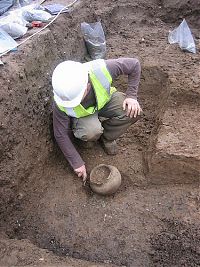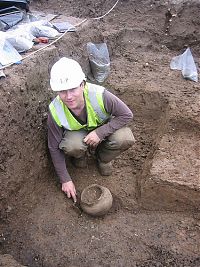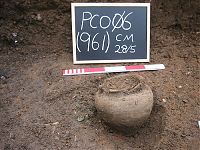Greg and context (961) - amongst others...
- By: Gregory Crees |
- May 29, 2008
- Share
- del.icio.us

Some more cremation urns are turning up already in this second phase of excavation. So far one complete urn has been excavated. It lay in a deposit of highly fragmentary burnt bone, and this deposit Context: 960 also included a total of six Roman coins (small find # <7-12> – no date ascertained yet due to bad corrosion). This fill though diffuse in places, seems to form the limits of a cut Context: 962, but we’re still cleaning the area and looking for any signs of anything possibly bigger that the urn could be within (since a really solid cut for this was not forthcoming – this has been a recurring problem so far because whoever dug the pit would have backfilled the cut with the same soil they removed when digging it – which means its harder for me to tell what material is within the cut and what is outside the cut!).
Some of the pot sherd turning up could represent other cremation urns that have been disturbed in later (i.e.medieval) times; and in fact there have been a few more solid lumps of broken but articulated pottery (including the whole base of vessel) that is more clearly identifiable as representing a individual urn. Some look like they’ve been broken from above or from the side. This sort of truncation may be indicating some damage having been caused by ploughing (we know the Roman cemetery fell out of use and other activities encroached on the area previously used as the cemetery).
Stratigraphically, the last day or two has been useful because we have clearly observed all the interesting cremation stuff turning up in a compact orangey clay material Context: 958 which is fairly easily discernable from the darker-browner stuff above. So when we come to excavate the area adjacent to its north side, we know what level to dig to before we can expect to find cremations. Having said this, I’m still trying to find the eastern edge of a large pit Context: 857excavated in part during the very end of phase one of the excavation – so the stratigraphy I’m observing now could actually only be relevant to this particular area, e.g. today another urn has appeared outside of the area I’m currently in, a few metres to my south and it seems to be truncated by a ditch running east-west across the site. Does this belong to another phase of burial or is it related to the material turning up where I am?


